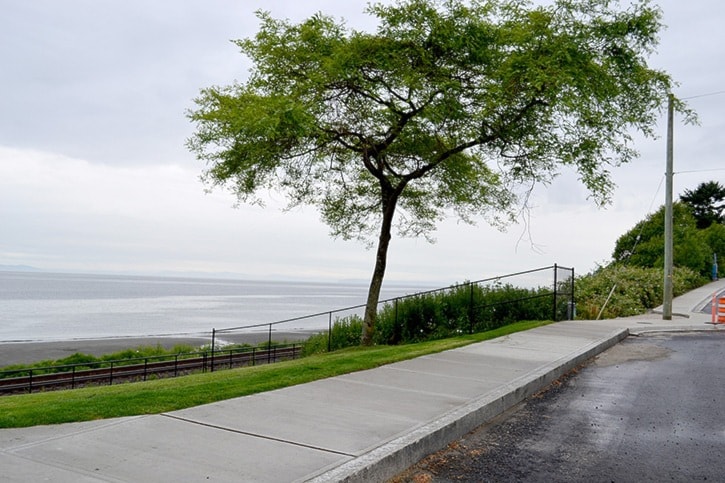The BNSF is not alone in concerns with trespassing on the White Rock waterfront.
According to Semiahmoo First Nation councillor Joanne Charles, railway plans to fence off the far eastern and western ends of the area is also trespassing on “significant” centuries-old native burial and archaeological sites.
She told Peace Arch News Wednesday that the band is asking the railway and Transport Canada to put on hold fencing on East Beach at the Finlay Street crossing and plans to block access on West Beach at the bottom of the Coldicutt Ravine, until an archaeological assessment of the beach area can be done.
“There need to be permits under the Heritage Act,” Charles said. “People should not be digging anywhere for anything without them.”
Measures to fence off and control access to the BNSF right-of-way, driven by safety concerns, have been made mandatory by a Transport Canada order, but a furor broke out when the City of White Rock interpreted the ruling to include a permanently locked gate at the West Beach Boat Launch crossing (which Transport Canada has since said was not necessary).
Charles said the band wrote to Transport Canada with its concerns about other planned fencing as soon as the controversy erupted several weeks ago. A meeting with BNSF officials is still pending rescheduling, she added, but work has been curtailed at the Finlay Street crossing.
“Transport Canada and the BNSF and the city may have been meeting on this since November, but Semiahmoo First Nation has not been afforded any dialogue on this,” she said.
BNSF spokesperson Gus Melonas could not be reached at PAN press time Wednesday afternoon but White Rock Mayor Wayne Baldwin said he understood the railway had placed Coldicutt Ravine work on hold due to Semiahmoo First Nation concerns.
Baldwin said most of these could be addressed through discussions with the railway and BNSF as they mostly apply to land outside of White Rock boundaries.
“We can only deal with our property,” he said.
He said White Rock’s policy, whenever archaeological remains of significance or a random burial site are encountered during work within the city, is to inform Semiahmoo First Nation and appropriate authorities.
“We do that anyway, as part of showing the necessary respect.”
But an archaeological-impact review of city property would be another matter, he said.
“As far as us doing a comprehensive total review of the entire city, we’ve never said that we’d do that. We couldn’t do it.”
Coldicutt Ravine has long been established as an area of archaeological sensitivity, Charles noted.
“There was a burial recovered from that area, in 1984-1985, which is now at SFU,” she said, adding the band plans to reclaim and re-inter those remains.
Charles said she doesn’t blame workers who come to install fences for doing their job.
“Some people just don’t know about this,” she said. “People are just doing what they’ve been told to do, but we need to have the opportunity to have dialogue and voice our concerns.”
The waterfront areas of Semiahmoo Bay and Crescent Beach, traditional home of the Semiahmoo people, are rife with archaeological remains, she said, including petroglyphs, fishing, habitation and burial sites.
“Any kind of development anywhere along the waterfront could have an impact on this,” she said.
“We need to have an archaeological-impact assessment of the whole area.”
Charles said new homeowners in Crescent Beach, particularly those remodeling older houses may also not be aware of the archaeological significance of the area.
“A lot of stuff has gone on down there, and people have managed to by-step the process – later they talk about it,” she said.
